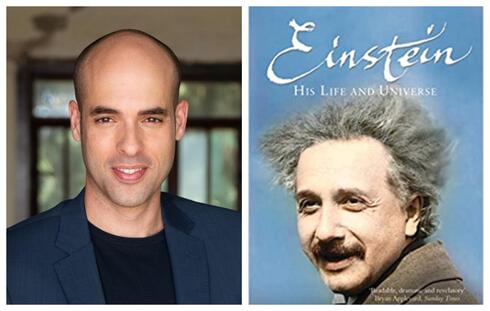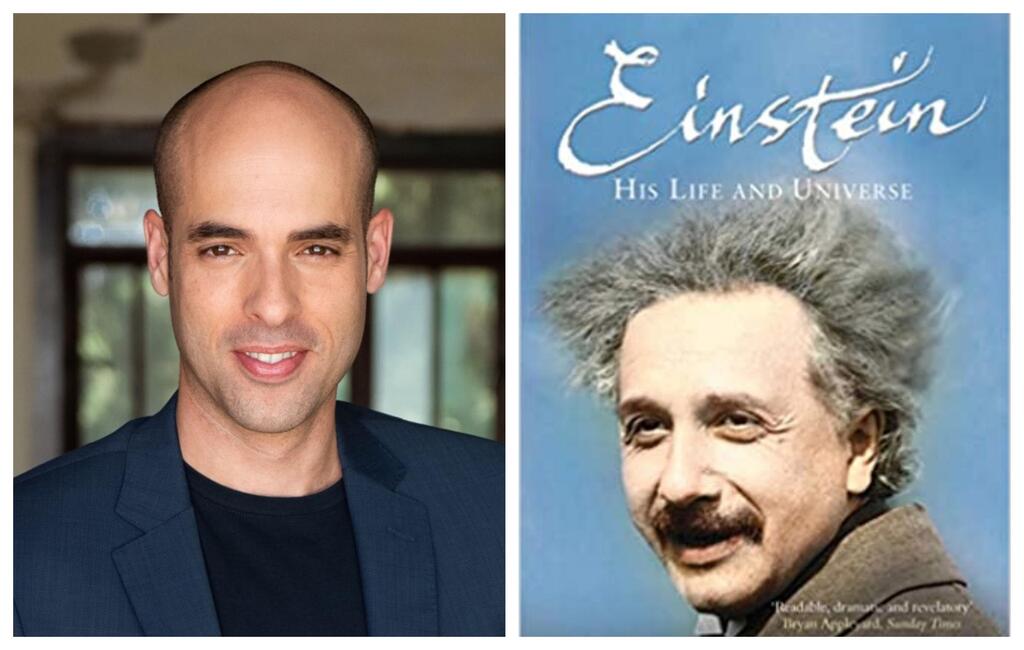
BiblioTech
CTech's Book Review: Maintaining a sense of innovation and creativity over time
Aran Erel, Country Manager for Israel, Greece and Cyprus at F5, shares insights after reading “Einstein: His Life and Universe” by Walter Isaacson
Aran Erel is the Country Manager for Israel, Greece and Cyprus at F5, a global multi-cloud application security and delivery company. He has joined CTech to share a review of “Einstein: His Life and Universe” by Walter Isaacson
Title: “Einstein: His Life and Universe"
Author: Walter Isaacson
Format: Book
Where: Home
1 View gallery


Aran Erel, Country Manager for Israel, Greece and Cyprus at F5
(Photo: Gabriel Baharlia)
Summary:
Walter Isaacson, author of the biographies of Benjamin Franklin and Steve Jobs, presents a biography of Albert Einstein, setting it in the broader historical context of the turbulent times in which he lived spanning two world wars.
Alongside his scientific achievements and his role in the Manhattan Project leading to the development of the atom bomb, the book sheds light on numerous other aspects of his life, such as his boundless creativity and innovation, his Jewish roots and links with the State of Israel, his attitude towards religion, and other key issues.
Isaacson succeeds in telling a fluent and fascinating tale focusing on Albert Einstein the person, going beyond the brilliant scientist known to us all, and portraying Einstein as a leader and visionary. A man who changed the world as we know it, from how we set satellite watches, to GPS and television, culminating in our understanding of how the universe operates.
Important Themes:
The most significant theme in the book, one that sums up Einstein’s life, deals with the ability to maintain a sense of innovation and creativity over time. Einstein’s success was the result of his rebellious nature and his refusal to fear dispute. Isaacson provides us with a profound study of the iconic genius, distinguishing between two key periods in Einstein’s life.
The first period of Einstein’s scientific career is characterized by tremendous spurts of creativity. Einstein challenged the accepted norms, the very foundations on which science and traditional thinking were based, and he did so by refusing to take anything for granted. The first of two bursts of creative energy in this period occurred in 1905, referred to as the “annus mirabilis” (year of miracles), including the publication of four papers within a 3-month period that laid the key foundations of modern physics. The first sets out to explain the nature of light, paving the way towards the invention of television and later awarding him the Nobel Prize for Physics. The second provided proof for the first time of the existence of atoms, while the third, “The Special Theory of Relativity”, perhaps epitomizing his sheer brilliance, genuinely changed the world and was published with almost no footnotes, access to information, or equipment. It all appears to be the product of Einstein’s own pure reasoning, written on simple exercise book paper and in hardly legible handwriting.
The second burst of creativity occurred in 1915 when Einstein arrived at his greatest achievement, “The General Theory of Relativity”. This did not come as easily and naturally to Einstein as in 1905, and he worked intensively, 20 hours a day, in a concerted effort to define equations and finalize his theory. Though this led to sickness (he contracted an ulcer and was confined to bed for several months), it left him with arguably the greatest scientific achievement of humankind.
In the second period of his career, Einstein found himself on the other side of the fence, facing the creative energy of the younger generation, which challenged scientific thinking. During this period, it was Einstein who had to defend his stance, yet he still managed to contribute much to science, even in those fields in which he disagreed with the ruling scientific thinking of the day.
What I’ve Learned:
We can learn different lessons from the various periods in Einstein’s life. His early period teaches us much about the need for technological leadership and innovation in the world of high-tech. Trailblazing companies looking to disrupt the market and challenge accepted norms must adopt an organizational culture that focuses on creative and perhaps even revolutionary thinking. Einstein arrived at his most significant breakthroughs when he questioned the scientific discoveries of the giants on whom he based his work (such as Isaac Newton). He had to contend with substantial opposition and subsequently developed a strong drive to prove himself.
Einstein’s second period illustrates just how technological giants, even if they started out as innovative trailblazers, can easily become bogged down or fail to progress if they do not continue to maintain the same subversive approach to thinking that originally led them to where they are now. We can equally learn from Einstein’s mistakes during this period and how mistakes enable us to become better entrepreneurs and managers. The most important inspiration I gained from the book is that if we do not allow ourselves and our teams to err, as part of the inbuilt organizational culture, we will not benefit from innovation nor will be able to have a significant impact on the market.
One of the most important insights is that there is no one quality or lifestyle that leads to innovation and success. Einstein was a complex and multilayered individual. He led a chaotic life, and the blend of character traits – rebellion and daring combined with perseverance and hard work, and spirituality (meditation and going on long walks) combined with intensive bursts of creativity and energetic activity – were a key to his success. We too should embrace such diversity among our workforce. Enabling each individual to find their unique expression is a key to organizational success.
Critiques:
Despite the huge volumes of material on which his research is based, some of which are presented for the first time in this book, Isaacson presents the information in a coherent and engaging manner both in terms of the historical periods of Einstein’s life and the various themes, such as his Jewish identity, romantic relations and involvement in the Manhattan Project. The book’s appeal is in the superbly crafted blend between science and the personal aspects of Einstein’s life. Despite its length, the book is captivating, enabling us to gain much more than a glimpse of what made Einstein tick as a man and not just a scientist.
Who Should Read This Book:
This book is for all those who love technology and science viewed through the prism of its historical context. It is highly recommended also for people seeking to impart values of innovation and entrepreneurship in their organization.














